Chlorophytum
Chlorophytum ist eine Pflanzengattung aus der Unterfamilie der Agavengewächse (Agavoideae) innerhalb der Familie der Spargelgewächse (Asparagaceae). Die 100 bis 190 Arten sind in der Paläotropis weitverbreitet.[1][2]
| Chlorophytum | ||||||||||||
|---|---|---|---|---|---|---|---|---|---|---|---|---|
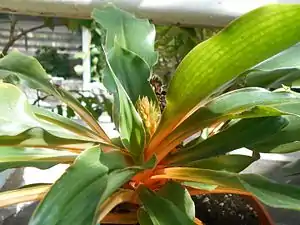
Chlorophytum orchidastrum | ||||||||||||
| Systematik | ||||||||||||
| ||||||||||||
| Wissenschaftlicher Name | ||||||||||||
| Chlorophytum | ||||||||||||
| Ker Gawl. |
Beschreibung
_(20317777534).jpg.webp)
Vegetative Merkmale
Die Chlorophytum-Arten wachsen als immergrüne oder laubabwerfende geophytische, ausdauernde, krautige Pflanzen. Ihre unterschiedlichen Wurzeln sind meist sukkulent oder gelegentlich knollig, mehr oder weniger dick oder fleischig. Die oft kurzen sowie unauffälligen, manchmal dicken sowie verlängerten, kriechenden Rhizome sind häufig mit alten Blattbasen bedeckt.[3][2]
Die Laubblätter sind rosettig oder büschelig angeordnet; selten sind sie auf ein einzelnes Blatt reduziert oder sind fast zweizeilig angeordnet. Die eingefalteten Laubblätter sind gestielt oder sitzend und es sind Blattscheiden vorhanden. Die einfache, kahle bis behaarte Blattspreite ist flach und länglich bis linealisch oder elliptisch-lanzettlich. Der Blattrand ist häufig gefranst.[3][2]
Blütenstände und Blüten
Die end- oder seitenständigen Blütenstandsschaft sind mit Hochblättern besetzt. Die traubige oder rispige Blütenstände besitzen Tragblätter. Der Blütenstiel ist nahe seiner Mitte gegliedert.[3][2]
Die zwittrigen Blüten sind radiärsymmetrisch und dreizählig. Die meist weiße, selten bis blaue Blütenhülle ist sternförmig, selten urnenförmig oder glockig. Die sechs freien länglichen Perigonblätter verbleiben vertrocknet, die Mittelrippe wird dunkler. Die äußeren Perigonblätter sind schmaler als die inneren Perigonblätter. Die sechs Staubblätter sind an der Basis der Blütenhüllblätter inseriert. Die fadenförmigen, meist nahe ihrer Mitte verbreitete Staubfäden sind kahl oder warzig. Die Staubbeutel fast basifix und intrors. Drei Fruchtblätter sind zu einem sitzenden oder kurz gestielten, dreikantigen, oberständigen Fruchtknoten verwachsen. Je Fruchtblatt sind ein bis mehrere Samenanlagen vorhanden. Die insgesamt 6 bis 30 sind im Fruchtknoten in zwei Reihen angeordnet. Der schlanke, stielrunde Griffel ist glatt und endet in einer relativ kleinen Narbe.[3][2]
Früchte und Samen
Die Früchte sind dreilappige oder dreikantige lokulizide Kapselfrüchte. Die glänzenden, schwarzen Samen sind flach und gerundet.[3][2]
.jpg.webp)
.jpg.webp)
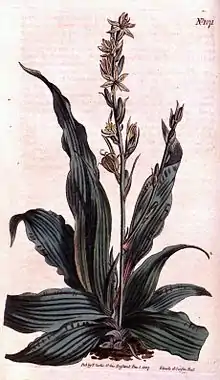
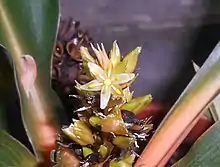
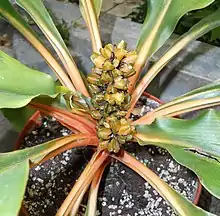
_(581813908).jpg.webp)
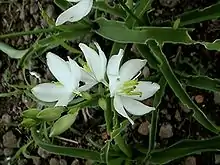
Systematik und Verbreitung
Die Gattung Chlorophytum ist in Afrika, auf Madagaskar und in Asien in Wäldern, Savannen und der Karoo-Vegetation verbreitet.
Die Erstbeschreibung der Gattung Chlorophytum erfolgte 1807 durch John Bellenden Ker Gawler.[4] Die Typusart der Gattung ist Chlorophytum inornatum. Der botanische Gattungsname Chlorophytum leitet sich von den griechischen Worten chloros für ‚gelblich grün‘ bzw. ‚hellgrün‘ sowie phyton für ‚Pflanze‘ ab und verweist auf die Färbung der Laubblätter einiger Taxa. Synonyme für Chlorophytum Ker Gawl. nom. cons. sind: Hartwegia Nees, Asphodelopsis Steud. ex Baker, Acrospira Welw. ex Baker nom. illeg., Dasystachys Baker nom. illeg., Debesia (Welw. ex Baker) Kuntze, Verdickia De Wild.[1]
Die Gattung Chlorophytum umfasst folgende Arten:[1]
- Chlorophytum acutum (C.H.Wright) Nordal
- Chlorophytum affine Baker:
- Chlorophytum affine Baker var. affine
- Chlorophytum affine var. curviscapum (Poelln.) Hanid
- Chlorophytum africanum (Baker) Baker:
- Chlorophytum africanum (Baker) Baker var. africanum
- Chlorophytum africanum var. nordalianum Meerts
- Chlorophytum africanum var. silvaticum (Dammer) Meerts
- Chlorophytum alismifolium Baker
- Chlorophytum alpinum Benth. ex Baker
- Chlorophytum altum Engl. & K.Krause
- Chlorophytum amplexicaule Baker
- Chlorophytum anceps (Baker) Kativu
- Chlorophytum andongense Baker
- Chlorophytum angulicaule (Baker) Kativu
- Chlorophytum angustiracemosum Poelln.
- Chlorophytum angustissimum (Poelln.) Nordal
- Chlorophytum ankarense H.Perrier: Sie kommt in Madagaskar vor.[1]
- Chlorophytum appendiculatum H.Perrier: Sie kommt in Madagaskar vor.[1]
- Chlorophytum applanatum Nordal & Thulin
- Chlorophytum arcuatoramosum R.B.Drumm.
- Chlorophytum aridum Oberm.
- Chlorophytum arundinaceum Baker
- Chlorophytum asperum J.C.Manning
- Chlorophytum aureum Engl.
- Chlorophytum basitrichum Poelln.
- Chlorophytum baturense K.Krause
- Chlorophytum belgaumense Chandore, Malpure, Adsul & S.R.Yadav
- Chlorophytum benuense Engl. & K.Krause
- Chlorophytum bharuchae Ansari, Sundararagh. & Hemadri
- Chlorophytum bifolium Dammer
- Chlorophytum blepharophyllum Schweinf. ex Baker:
- Chlorophytum blepharophyllum var. amplexicaule (Baker) Meerts
- Chlorophytum blepharophyllum Schweinf. ex Baker subsp. blepharophyllum
- Chlorophytum blepharophyllum subsp. pendulum Hoell & Nordal
- Chlorophytum blepharophyllum subsp. rubropygmaeum Bjorå & Nordal
- Chlorophytum boomense Kativu
- Chlorophytum borivilianum Santapau & R.R.Fern.
- Chlorophytum bowkeri Baker
- Chlorophytum brachystachyum Baker
- Chlorophytum bracteatum Hua
- Chlorophytum brevipedunculatum Poelln.
- Chlorophytum breviscapum Dalzell
- Chlorophytum bulbinifolium Hoell & Nordal
- Chlorophytum burundiense Meerts
- Chlorophytum calyptrocarpum (Baker) Kativu
- Chlorophytum cameronii (Baker) Kativu:
- Chlorophytum cameronii (Baker) Kativu var. cameronii
- Chlorophytum cameronii var. grantii (Baker) Nordal
- Chlorophytum cameronii var. purpuratum (Rendle) Govaerts
- Chlorophytum camporum Engl. & K.Krause
- Chlorophytum capense (L.) Voss
- Chlorophytum caudatibracteatum Engl. & K.Krause
- Chlorophytum caulescens (Baker) Marais & Reilly
- Chlorophytum chelindaense Kativu & Nordal
- Chlorophytum chevalieri Poelln.
- Chlorophytum chinense Bureau & Franch.: Sie gedeiht an Waldrändern, Grashängen und Ufern von Fließgewässern in Höhenlagen von 2600 bis 3000 Metern nur in den chinesischen Provinzen südwestlichen Sichuan sowie nordwestlichen Yunnan.[2]
- Chlorophytum chloranthum Baker: Sie kommt in Madagaskar vor.[1]
- Chlorophytum clarae Bjorå & Nordal
- Chlorophytum collinum (Poelln.) Nordal
- Chlorophytum colubrinum (Baker) Engl.:
- Chlorophytum colubrinum (Baker) Engl. var. colubrinum
- Chlorophytum colubrinum var. upembense Meerts
- Chlorophytum comosum (Thunb.) Jacques (Grünlilie)
- Chlorophytum cooperi (Baker) Nordal
- Chlorophytum cordifolium De Wild.
- Chlorophytum crassinerve (Baker) Oberm.
- Chlorophytum cremnophilum van Jaarsv.
- Chlorophytum crispum (Thunb.) Baker
- Chlorophytum cyperaceum (Kies) Nordal
- Chlorophytum dalzielii (Hutch. ex Hepper) Nordal
- Chlorophytum debile Baker
- Chlorophytum decaryanum H.Perrier: Sie kommt in Madagaskar vor.[1]
- Chlorophytum decipiens Baker: Sie kommt in Madagaskar vor.[1]
- Chlorophytum densiflorum Engl.
- Chlorophytum dianellifolium (Baker) H.Perrier: Sie kommt in Madagaskar vor.[1]
- Chlorophytum distichum H.Perrier: Sie kommt in Madagaskar vor.[1]
- Chlorophytum diwanjii Mujaffar, A.P.Tiwari & Chandore
- Chlorophytum dolichocarpum Tamura
- Chlorophytum ducis-aprutii Chiov.
- Chlorophytum fasciculatum (Baker) Kativu
- Chlorophytum filifolium Nordal & Thulin
- Chlorophytum filipendulum Baker:
- Chlorophytum filipendulum Baker subsp. filipendulum
- Chlorophytum filipendulum subsp. amaniense (Engl.) Nordal & A.D.Poulsen
- Chlorophytum fischeri (Baker) Baker
- Chlorophytum gallabatense Schweinf. ex Baker:
- Chlorophytum gallabatense var. floribundum (Baker) Meerts
- Chlorophytum gallabatense Schweinf. ex Baker var. gallabatense
- Chlorophytum gallabatense var. micranthum (Baker) Meerts
- Chlorophytum galpinii (Baker) Kativu:
- Chlorophytum galpinii (Baker) Kativu var. galpinii
- Chlorophytum galpinii var. matabelense (Baker) Kativu
- Chlorophytum galpinii var. norlindhii (Weim.) Kativu
- Chlorophytum geayanum (H.Perrier) Marais & Reilly: Sie kommt in Madagaskar vor.[1]
- Chlorophytum geophilum Peter ex Poelln.
- Chlorophytum glaucoides Blatt.
- Chlorophytum glaucum Dalzell
- Chlorophytum goetzei Engl.
- Chlorophytum gothanense Malpure & S.R.Yadav
- Chlorophytum gracile Baker: Sie kommt in Madagaskar vor.[1]
- Chlorophytum graminifolium (Willd.) Kunth
- Chlorophytum graniticola Kativu
- Chlorophytum graniticum H.Perrier: Sie kommt in Madagaskar vor.[1]
- Chlorophytum graptophyllum (Baker) Marais & Reilly
- Chlorophytum haygarthii J.M.Wood & M.S.Evans
- Chlorophytum herrmannii Nordal & Sebsebe
- Chlorophytum heynei Baker
- Chlorophytum hiranense Nordal & Thulin
- Chlorophytum hirsutum A.D.Poulsen & Nordal
- Chlorophytum holstii Engl.
- Chlorophytum humbertianum H.Perrier: Sie kommt in Madagaskar vor.[1]
- Chlorophytum humifusum Cufod.
- Chlorophytum hypoxiforme (H.Perrier) Marais & Reilly: Sie kommt in Madagaskar vor.[1]
- Chlorophytum hysteranthum Kativu
- Chlorophytum immaculatum (Hepper) Nordal
- Chlorophytum inconspicuum (Baker) Nordal
- Chlorophytum indicum (Willd. ex Schult. & Schult.f.) Dress
- Chlorophytum inornatum Ker Gawl.
- Chlorophytum intermedium Craib
- Chlorophytum kolhapurense Sardesai, S.P.Gaikwad & S.R.Yadav
- Chlorophytum krauseanum (Dinter) Kativu
- Chlorophytum krookianum Zahlbr.
- Chlorophytum lancifolium Welw. ex Baker:
- Chlorophytum lancifolium Welw. ex Baker subsp. lancifolium
- Chlorophytum lancifolium subsp. cordatum (Engl.) A.D.Poulsen & Nordal
- Chlorophytum lancifolium subsp. togoense (Engl.) A.D.Poulsen & Nordal
- Chlorophytum latifolium Engl. & K.Krause
- Chlorophytum laxum R.Br.: Sie kommt in Indien, Indonesien, Malaysia, Myanmar, Sri Lanka, Thailand, China, im tropischen Afrika und in Australien vor.[2]
- Chlorophytum leptoneurum (C.H.Wright) Poelln.:
- Chlorophytum leptoneurum var. katangense (De Wild.) Meerts
- Chlorophytum leptoneurum (C.H.Wright) Poelln. var. leptoneurum
- Chlorophytum lewisae Oberm.
- Chlorophytum limosum (Baker) Nordal
- Chlorophytum littorale Nordal & Thulin
- Chlorophytum longifolium Schweinf. ex Baker:
- Chlorophytum longifolium var. aureum (Engl.) Meerts
- Chlorophytum longifolium Schweinf. ex Baker var. longifolium
- Chlorophytum longiscapum Dammer
- Chlorophytum longissimum Ridl.
- Chlorophytum macrophyllum (A.Rich.) Asch.
- Chlorophytum macrorrhizum Poelln.
- Chlorophytum macrosporum Baker
- Chlorophytum madagascariense Baker: Sie kommt in Madagaskar vor.[1]
- Chlorophytum malabaricum Baker
- Chlorophytum malayense Ridl.: Sie kommt in Laos, Malaysia, Thailand, Vietnam, in Guangxi und im südlichen Yunnan in Höhenlagen von 400 bis 1500 Metern Meereshöhe vor.[2]
- Chlorophytum mamillatum Elden & Nordal: Sie wurde 2017 aus Äthiopien erstbeschrieben.[1]
- Chlorophytum micranthum Baker
- Chlorophytum minor Kativu
- Chlorophytum modestum Baker
- Chlorophytum monophyllum Oberm.
- Chlorophytum namaquense Schltr. ex Poelln.
- Chlorophytum namorokense H.Perrier: Sie kommt in Madagaskar vor.[1]
- Chlorophytum nepalense (Lindl.) Baker: Sie gedeiht vom nordöstlichen Indien über Nepal, Sikkim, Bhutan sowie Myanmar bis Tibet und den chinesischen Guizhou, Sichuan sowie Yunnan.[2]
- Chlorophytum nervatum (C.H.Wright) Poelln.
- Chlorophytum nervosum Nordal & Thulin
- Chlorophytum nidulans (Baker) Brenan
- Chlorophytum nimmonii Dalzell
- Chlorophytum nubicum (Baker) Kativu
- Chlorophytum nyasae (Rendle) Kativu
- Chlorophytum nzii A.Chev. ex Hepper
- Chlorophytum occultum A.D.Poulsen & Nordal
- Chlorophytum orchidastrum Lindl.
- Chlorophytum palghatense K.M.P.Kumar & Adsul
- Chlorophytum parkeri (Baker) Marais & Reilly: Sie kommt in Madagaskar vor.[1]
- Chlorophytum parvulum Chiov.
- Chlorophytum paucinervatum (Poelln.) Nordal
- Chlorophytum pauciphyllum Oberm.
- Chlorophytum pauper Poelln.
- Chlorophytum pendulum Nordal & Thulin
- Chlorophytum peralbum Poelln.
- Chlorophytum perfoliatum Kativu
- Chlorophytum petraeum Nordal & Thulin
- Chlorophytum petrophilum K.Krause
- Chlorophytum pilosicarinatum (Poelln.) Meerts
- Chlorophytum pilosissimum Engl. & K.Krause
- Chlorophytum polystachys Baker
- Chlorophytum pseudocaule Tesfaye & Nordal
- Chlorophytum pterocarpum Nordal & Thulin
- Chlorophytum puberulum Engl.
- Chlorophytum pubiflorum Baker
- Chlorophytum pusillum Schweinf. ex Baker
- Chlorophytum pygmaeum (Weim.) Kativu:
- Chlorophytum pygmaeum (Weim.) Kativu subsp. pygmaeum
- Chlorophytum pygmaeum subsp. rhodesianum (Rendle) Kativu
- Chlorophytum radula (Baker) Nordal
- Chlorophytum ramosissimum Nordal & Thulin
- Chlorophytum rangei (Engl. & K.Krause) Nordal
- Chlorophytum recurvifolium (Baker) C.Archer & Kativu
- Chlorophytum reflexibracteatum Poelln.
- Chlorophytum rhizopendulum Bjorå & Hemp
- Chlorophytum rigidum Kunth
- Chlorophytum ruahense Engl.
- Chlorophytum rubribracteatum (De Wild.) Kativu
- Chlorophytum rutenbergianum Vatke: Sie kommt in Madagaskar vor.[1]
- Chlorophytum saundersiae (Baker) Nordal
- Chlorophytum scabrum Baker
- Chlorophytum senegalense (Baker) Hepper
- Chlorophytum serpens Sebsebe & Nordal
- Chlorophytum sharmae Adsul, Lekhak & S.R.Yadav
- Chlorophytum silvaticum Dammer
- Chlorophytum simplex Craib
- Chlorophytum sofiense (H.Perrier) Marais & Reilly: Sie kommt in Madagaskar vor.[1]
- Chlorophytum somaliense Baker
- Chlorophytum sparsiflorum Baker:
- Chlorophytum sparsiflorum Baker var. sparsiflorum
- Chlorophytum sparsiflorum var. bipindense (Engl. & K.Krause) Bjorå & Nordal
- Chlorophytum sphacelatum (Baker) Kativu
- Chlorophytum sphagnicola Meerts
- Chlorophytum staudtii Nordal
- Chlorophytum stenopetalum Baker
- Chlorophytum stenopetalum var. latifolium (Engl. & K.Krause) Meerts
- Chlorophytum stenopetalum var. stenopetalum
- Chlorophytum stolzii (K.Krause) Weim.
- Chlorophytum subligulatum H.Perrier: Sie kommt in Madagaskar vor.[1]
- Chlorophytum subpetiolatum (Baker) Kativu:
- Chlorophytum subpetiolatum var. pilosifolium (De Wild.) Meerts
- Chlorophytum subpetiolatum (Baker) Kativu var. subpetiolatum
- Chlorophytum suffruticosum Baker
- Chlorophytum superpositum (Baker) Marais & Reilly
- Chlorophytum sylvestre Bardot-Vaucoulon: Sie kommt in Madagaskar vor.[1]
- Chlorophytum tenerrimum Peter ex Poelln.
- Chlorophytum tetraphyllum (L. f.) Baker
- Chlorophytum transvaalense (Baker) Kativu
- Chlorophytum trichophlebium (Baker) Nordal
- Chlorophytum triflorum (Aiton) Kunth
- Chlorophytum tripedale (Baker) H.Perrier: Sie kommt in Madagaskar vor.[1]
- Chlorophytum unyikense Engl.
- Chlorophytum velutinum Kativu
- Chlorophytum vestitum Baker:
- Chlorophytum vestitum subsp. pilosissimum (Engl. & K.Krause) Meerts
- Chlorophytum vestitum Baker subsp. vestitum
- Chlorophytum viridescens Engl.
- Chlorophytum viscosum Kunth
- Chlorophytum waibelii K.Krause
- Chlorophytum warneckei (Engl.) Marais & Reilly
- Chlorophytum zambiense Bjorå & Nordal
- Chlorophytum zavattarii (Cufod.) Nordal
- Chlorophytum zingiberastrum Nordal & A.D.Poulsen
Nachweise
Literatur
- Chen Xinqi (陈心启 Chen Sing-chi), Minoru N. Tamura: Chlorophytum., S. 205-206 - textgleich online wie gedrucktes Werk, In: Wu Zheng-yi, Peter H. Raven (Hrsg.): Flora of China. Volume 24: Flagellariaceae through Marantaceae. Science Press und Missouri Botanical Garden Press, Beijing und St. Louis, 2000, ISBN 0-915279-83-5.
- Ernst Jacobus van Jaarsveld: Chlorophytum. In: Urs Eggli (Hrsg.): Illustrated Handbook of Succulent Plants: Monocotyledons - Illustrated Handbook of Succulent Plants. Springer Science & Business Media, Berlin, Heidelberg 2012, ISBN 978-3-642-56715-5, S. 228–229 (Chlorophytum in der Google-Buchsuche).
- A. Amelia Obermeyer: A revision of the South African species of Anthericum, Chlorophytum and Trachyandra. In: Bothalia. Band 7, Nummer 4, 1962, S. 669–767.
Einzelnachweise
- Rafaël Govaerts (Hrsg.): Chlorophytum. In: World Checklist of Selected Plant Families (WCSP) – The Board of Trustees of the Royal Botanic Gardens, Kew, abgerufen am 19. Januar 2022.
- Chen Xinqi (陈心启 Chen Sing-chi), Minoru N. Tamura: Chlorophytum., S. 205-206 - textgleich online wie gedrucktes Werk, In: Wu Zheng-yi, Peter H. Raven (Hrsg.): Flora of China. Volume 24: Flagellariaceae through Marantaceae. Science Press und Missouri Botanical Garden Press, Beijing und St. Louis, 2000, ISBN 0-915279-83-5.
- Ernst Jacobus van Jaarsveld: Chlorophytum. In: Urs Eggli (Hrsg.): Sukkulenten-Lexikon. Einkeimblättrige Pflanzen (Monocotyledonen). Eugen Ulmer, Stuttgart 2001, ISBN 3-8001-3662-7, S. 236–237.
- Curtis’s Botanical Magazine. Band 27, 1807, Tafel 1071 (eingescannt bei biodiversitylibrary.org).
Weblinks
- Chlorophytum in der Roten Liste gefährdeter Arten der IUCN 2016. Abgerufen am 14. September 2016.
- Artenliste zu Chlorophytum in der Red List of South African Plants